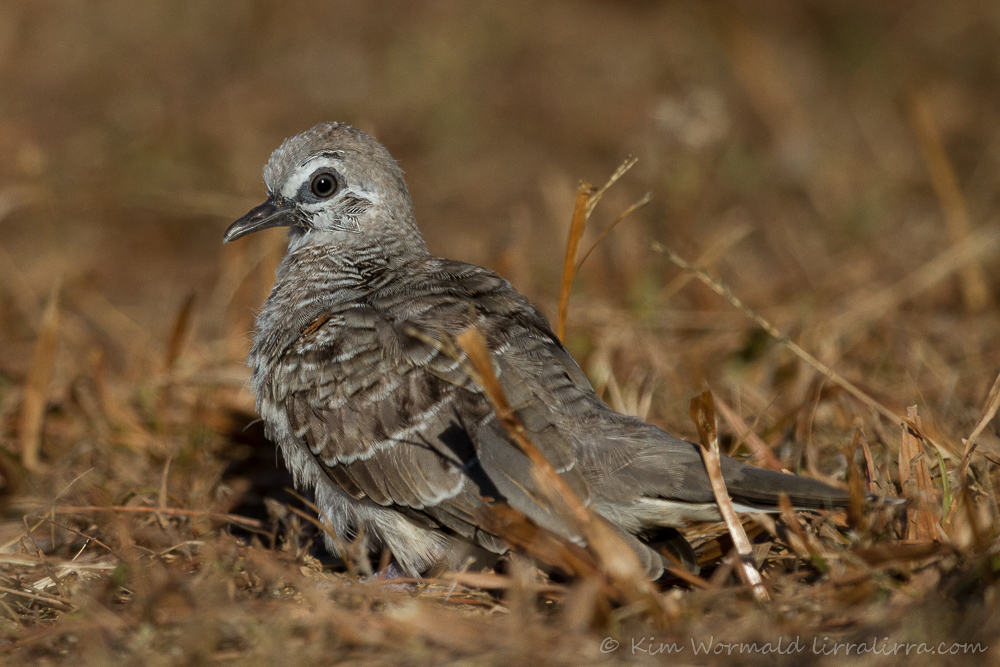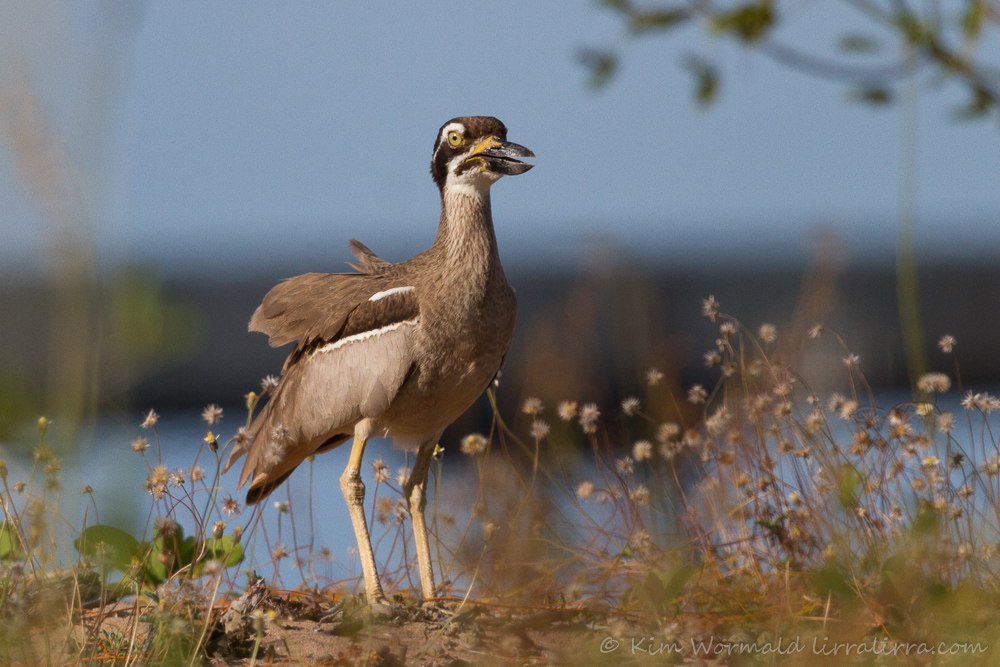Late one afternoon I went walkabout in north Queensland, hoping to see a Beach Stone-curlew. As I walked across the foreshore there was a lone Peaceful Dove foraging in the shadows, a juvenile, I’m more used to seeing these doves in pairs or family groups. I moved slowly until my camera was resting on the drought-stricken grass and while I watched the dove moved from the shadows and turned to look at me.
 Peaceful Dove (Geopelia striata)
Peaceful Dove (Geopelia striata)
Canon 7D, 100-400mm L IS USM, f/5.6, 1/3200, ISO 400, focal length 400mm
Juvenile Peaceful Doves have softer barring on their feathers than the adults and their eye-ring, eye and cere are greyer than the pastel blue they will become. They are small doves, averaging 22mm and weighing about 50g. They feed mainly on grass seeds but also take occasional insects. They are never too far from water as they need to drink twice each day. I stayed watching this cute little bird for quite a while before continuing my quest for the vulnerable Beach Stone-curlew I didn’t expect to see.
 Beach Stone-curlew (Esacus magnirostris)
Beach Stone-curlew (Esacus magnirostris)
Canon 7D, 100-400mm L IS USM, f/5.6, 1/2500, ISO 400, exposure compensation +1/3, focal length 400mm
I walked slowly inland from the beach, stepping carefully to check for waders’ nests, and pausing often to scan the area. I was about 30m from the beach when I caught sight of my first and only Beach Stone-curlew. It froze, then ran a few paces, then froze again: it was so comical. I hunkered down and watched as it continued running and freezing in a circle around me, almost as though it was connected to me by a long string.
 Beach Stone-curlew ((Esacus magnirostris)
Beach Stone-curlew ((Esacus magnirostris)
Canon 7D, 100-400mm L IS USM, f/5.6, 1/3200, ISO 400, exposure compensation +1/3, focal length 400mm
I took several images but my favourites are the two I’ve posted. The stone-curlew ran behind a bush and I thought that I wouldn’t see it again but it reappeared and came closer to me before freezing again and looking at me with a surprised expression on its face. I probably had a surprised expression on my face too.
During the same trip I also saw the Bush Stone-curlew that featured in an earlier post. The two curlews are the same size (about 56cm and weighing 1kg, that’s 20 times the weight of the dove). The Beach Stone-curlew has a larger bill and subtler markings than its ‘cousin’. I wasn’t lucky enough to see a juvenile which are looked after by the parents for up to 12 months, nor did I hear their mournful wailing call but it’s always good to save something for next time.
Happy birding, Kim
NB It is possible to receive a weekly email letting you know that lirralirra has been updated – just add your address to the ‘Subscribe to email’ box above right.
Also, I recently added a Facebook ‘like’ button. Thank you ‘likers’ – I like you too!

The Beach Stone-curlew behavior is somewhat like the Plovers in North America – running a short distance and then stopping. But on the beaches, they don’t run in circles! When I am lucky, they run toward me. The markings of the juvenile Peaceful Dove are very distinctive and your image provides excellent detail.
Dave
That’s true about Aussie plovers too, I hadn’t thought about them when writing the post. I’m not sure if Beach Stone-curlews generally run in circles or if it was just trying to work out what was sitting in its territory – I’d love to get a chance to find out!
Beautiful photos! I love the Stone Curlew! What a cutie! Have a happy weekend!
Thanks Eileen, a happy weekend to you too!
Second attempt. Today it seems basic mathematics is beyond me, so I failed the Captcha.
Wow, wow, and wow. I can feel your excitement and couldn’t help thinking when I looked at the stunning images of the Beach Stone-Curlew that his relationship to the dinosaur is still evident.
Sorry about the captcha! That is such an interesting thought about the dinosaur, you’re absolutely right.
Hi Kim, very interesting photos, the peaceful dove is very cute, I like the beach stone-curlew for the markings on its feathers, does it fly at all.
I’m glad you like the dove, I think it’s a beautiful little bird. Beach Stone-curlews can fly but only do so as a last resort if disturbed. Their feathers are quite unique, it would have been nice if it’d had come closer so I’d got a better image of the pattern.
it s a fun story for you, and nice pictures too, i completly imagine this bird run a bit, stay froze and run again, it s excellent =)))
thanks kim, and happy birding ^^
I’m glad you can imagine how funny it looked, I was lucky that it ran right around me
My first Beach Stone-curlew was at Darwin.
I’m not sure but I saw one not far from the Casino, (not that I was gambling). Dogs everywhere on the beaches but the Curlews don’t seem to mind so much if there is a good distance.
Mal
That would have been great! I know the exact area you mean but didn’t see one there. I guess one problem would be dogs disturbing nests, it’s a wonder any of our ground-nesters are surviving.